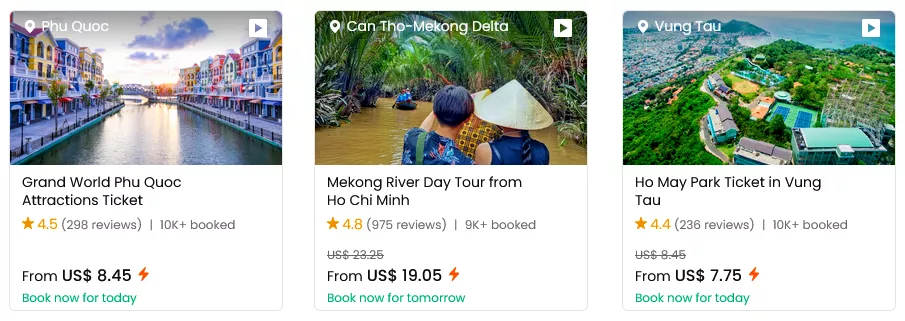
ℹ️ Useful Information
🤔 To Go / Not to Go?
🍜 Food / Cuisine
✈️ How to get there
☀️ Weather Forecast
🏡 Where to stay
🔍 Activities + Places
❓ FAQ + Travel Tips
🎫 Book a Tour Online
🎫 Book Tickets / Car
Quick answer: Southern Vietnam is a dynamic and diverse region where city energy, river life, and tropical coastlines meet. Here you’ll find the bustling streets of Ho Chi Minh City, peaceful boat rides through the Mekong Delta, historic sites, and relaxing island escapes. The mix of culture, nature, and adventure makes it a must‑see part of Vietnam.
At a glance:
- 🌆 Ho Chi Minh City (Saigon): A lively metropolis with markets, history, and street food.
- 🚤 Mekong Delta: Explore floating markets, river villages, and lush waterways.
- 🏯 Historic sites: Visit the Cu Chi Tunnels to learn about wartime history.
- 🍽️ Rich cuisine: Taste fresh food, tropical fruits, and Mekong specialties.
- 🏝️ Islands & beach escapes: Relax on islands like Phu Quoc for beach time and nature.
- 🕌 Temples & pagodas: Visit beautiful river temples like Tây An and Vĩnh Tràng.
- 📅 Best time to go: Weather varies, but many travelers enjoy the dry season for river and coastal trips.
Last updated in November 2025.
Location and Geography of Southern Vietnam:
Southern Vietnam is a captivating region that lies at the southernmost part of the country, encompassing a diverse landscape that ranges from bustling urban centers to fertile deltas and pristine coastlines. It is one of the three main regions of Vietnam, along with the North and Central regions, and plays a crucial role in the country’s economic and cultural development.
-
- Geographical Features: Southern Vietnam is characterized by its fertile plains, meandering rivers, and vast deltas. The Mekong River, one of the most significant rivers in Southeast Asia, flows through the region, creating the lush Mekong Delta. The delta is a mosaic of rice paddies, fruit orchards, and picturesque waterways, often referred to as the „Rice Bowl“ of Vietnam due to its abundant agricultural output.
- Key Cities and Provinces: The southern region is home to major cities that thrive with economic activity and cultural vibrancy. Ho Chi Minh City, the largest city in Vietnam, serves as the economic hub and pulsating heart of the region. With its skyscrapers, bustling markets, and historical landmarks, Ho Chi Minh City captures the essence of modern Vietnam. Other notable cities in Southern Vietnam include Can Tho, the economic center of the Mekong Delta, famous for its floating markets and agricultural products, and Vung Tau, a popular coastal resort town known for its pristine beaches and scenic landscapes.
- Climate: Southern Vietnam experiences a tropical climate characterized by two distinct seasons – the dry season and the rainy season. The dry season typically lasts from November to April, with pleasant temperatures and lower humidity. Meanwhile, the rainy season extends from May to October, bringing occasional heavy rainfall and high humidity.
- Economic Significance: The southern region is a powerhouse of economic growth and industrial development in Vietnam. It plays a vital role in trade, manufacturing, agriculture, and tourism. The Mekong Delta’s fertile lands are not only essential for rice cultivation but also for the production of fruits, seafood, and other agricultural products that contribute significantly to Vietnam’s export economy.
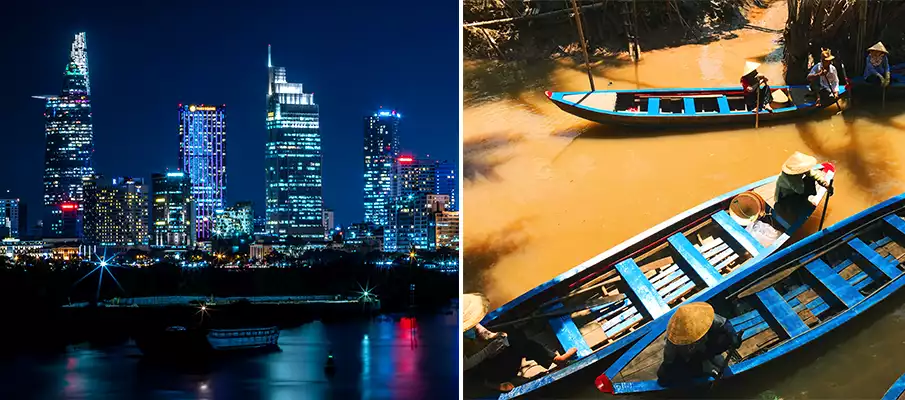
History of Southern Vietnam: A Journey Through Time:
Southern Vietnam boasts a storied past that spans centuries, shaped by various empires, colonial powers, and cultural influences. From ancient civilizations to modern developments, the region’s history has played a crucial role in shaping the nation’s identity and growth.
-
- Ancient Civilizations: Southern Vietnam’s history can be traced back to the early centuries AD when the region was home to the indigenous Funan and Chenla kingdoms. These ancient civilizations thrived along the Mekong River and engaged in maritime trade, leaving behind traces of their culture and architecture.
- Khmer Influence: During the Angkorian period, the mighty Khmer Empire extended its influence over parts of Southern Vietnam, leaving behind remarkable temples and structures, such as the magnificent temples of Oc Eo and Angkor Borei.
- Colonial Era: The arrival of European colonial powers in the 17th century marked a significant turning point in Southern Vietnam’s history. The French gradually established control over the region during the 19th century, leading to the establishment of French Cochinchina. The city of Saigon (now Ho Chi Minh City) became the capital of French Indochina.
- Vietnamese Independence Struggle: Southern Vietnam played a crucial role in the fight for independence from colonial rule. The mid-20th century witnessed significant political upheavals, with the establishment of the Viet Minh and the subsequent Vietnam War, which culminated in the fall of Saigon in 1975 and the reunification of Vietnam.
- Post-War Development: After the war, Southern Vietnam, along with the rest of the country, entered a period of rebuilding and development. The region experienced rapid economic growth, with Ho Chi Minh City emerging as a bustling commercial and cultural hub.
- Modern Southern Vietnam: Today, Southern Vietnam stands as a dynamic and prosperous region, showcasing a blend of tradition and modernity. It continues to attract tourists from around the world with its diverse cultural heritage, historical landmarks, and breathtaking landscapes.
BOOK a TOUR / ACTIVITY in Vietnam ➜
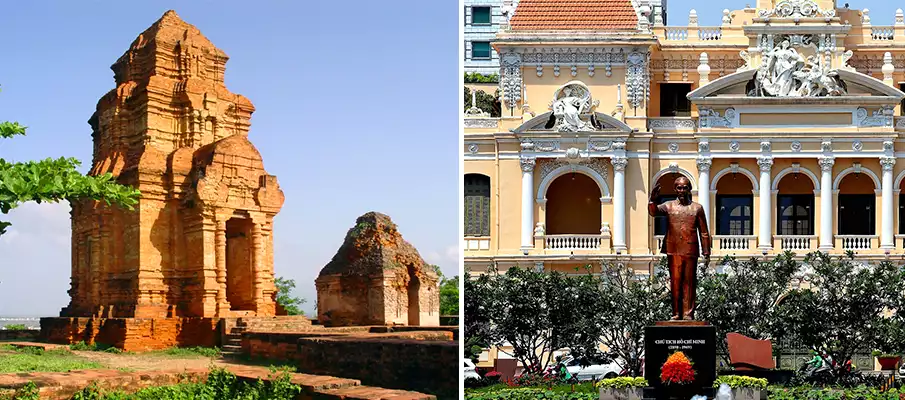
Festivals and Culture: Celebrating Traditions in Southern Vietnam:
Southern Vietnam’s vibrant cultural tapestry is enriched by a diverse array of festivals and traditions that reflect the region’s deep-rooted heritage and harmonious coexistence of various ethnic communities. Throughout the year, the southern part of the country comes alive with colorful festivities, religious ceremonies, and captivating cultural practices that captivate locals and visitors alike.
-
- 1. Tet Festival (Lunar New Year): Tet, the Vietnamese Lunar New Year, is the most significant and widely celebrated festival in Southern Vietnam. Families come together to honor their ancestors, offer prayers at temples, and enjoy sumptuous feasts. Streets are adorned with lanterns, and traditional lion dances fill the air with festive spirit.
- 2. Nghinh Ong Festival: The Nghinh Ong Festival is a cultural highlight in Southern Vietnam, particularly in coastal cities like Vung Tau and Can Gio. Dedicated to the Sea Goddess, the festival celebrates the importance of the sea and fishing to the local communities, featuring vibrant processions and elaborate rituals.
- 3. Mid-Autumn Festival (Tet Trung Thu): Celebrated on the 15th day of the eighth lunar month, the Mid-Autumn Festival is a joyous occasion for families to gather, share mooncakes, and enjoy colorful lantern parades. Children carry lanterns shaped like animals or characters from folklore, creating a mesmerizing sight.
- 4. Ok Om Bok Festival: Unique to the Khmer community in Southern Vietnam, Ok Om Bok is a traditional moon-worshipping festival held in Soc Trang and Tra Vinh provinces. Locals gather to give thanks to the Moon Goddess for the bountiful harvest, featuring boat races and vibrant cultural performances.
- 5. Kate Festival: Another significant festival celebrated by the Khmer people is the Kate Festival, observed at temples across Southern Vietnam. This religious event involves colorful processions, traditional dances, and offerings to honor their ancestors and seek blessings from deities.
- 6. Ooc Om Boc Festival: Also known as the „Worshipping the Moon,“ Ooc Om Boc is a unique festival of the Khmer community in Tra Vinh Province. During this event, locals release lanterns into the sky and float offerings on rivers to express gratitude to the Moon for favorable weather and good crops.
- 7. Buffalo Fighting Festival: In An Giang Province, the Buffalo Fighting Festival is a traditional event that showcases the skill and strength of powerful water buffalos. Farmers proudly present their buffalos, and spectators cheer as the animals compete in friendly matches.
- 8. Southern Folk Music and Dance: Southern Vietnam is renowned for its captivating folk music and dance forms, such as „Don Ca Tai Tu“ and „Cai Luong.“ These cultural performances showcase the region’s artistic talents and storytelling traditions.
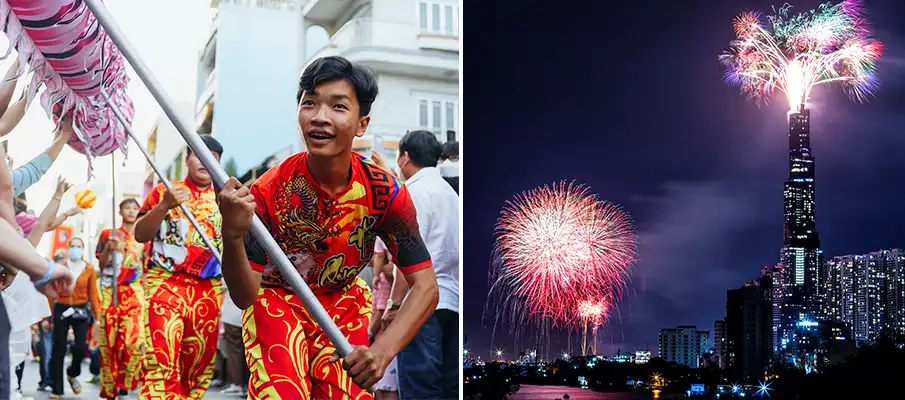
Economic Powerhouse: Southern Vietnam’s Prosperous Growth:
Southern Vietnam is a powerhouse of economic growth and development, playing a pivotal role in Vietnam’s rapidly expanding economy. Boasting bustling cities, fertile agricultural lands, and a robust industrial sector, the region serves as a dynamic hub for trade, manufacturing, and tourism.
-
- 1. Industrial Development: The southern region is a major industrial center in Vietnam, with a concentration of manufacturing facilities, export processing zones, and industrial parks. Cities like Ho Chi Minh City, Binh Duong, and Dong Nai are home to a diverse range of industries, including textiles, electronics, food processing, and automotive manufacturing.
- 2. Agricultural Productivity: The Mekong Delta, often referred to as the „Rice Bowl“ of Vietnam, lies in Southern Vietnam and is known for its fertile plains and extensive network of rivers and canals. The region is a leading producer of rice, fruits, and seafood, contributing significantly to Vietnam’s agricultural output and export revenue.
- 3. International Trade: Southern Vietnam’s strategic location along the coast and proximity to major seaports has facilitated international trade and commerce. Ports such as Cat Lai, Cai Mep, and Vung Tau handle a substantial volume of container traffic, making the region an essential gateway for imports and exports.
- 4. Service Sector and Tourism: The service sector, particularly in Ho Chi Minh City, is a thriving component of Southern Vietnam’s economy. The city is a commercial and financial hub, hosting a wide range of businesses, hotels, restaurants, and entertainment venues. Tourism is also a significant contributor to the economy, with the region attracting visitors from around the world to its cultural landmarks, vibrant nightlife, and coastal resorts.
- 5. Infrastructure Development: Investments in infrastructure development have been crucial to supporting the region’s economic growth. Modern transportation networks, including highways, railways, and airports, connect Southern Vietnam with other regions, facilitating the movement of goods and people.
- 6. Foreign Direct Investment (FDI): Southern Vietnam attracts substantial foreign direct investment due to its favorable business environment and well-established industrial base. Multinational corporations invest in the region to take advantage of the skilled workforce, logistical advantages, and growing consumer market.

What to Expect from Tourism in Southern Vietnam:
Southern Vietnam is a region that beckons travelers with its captivating blend of cultural treasures and natural wonders. From bustling urban centers to serene coastal getaways and lush countryside, the region offers a diverse range of experiences for every type of traveler.
-
- Cultural Delights: Southern Vietnam boasts a rich cultural heritage shaped by ancient civilizations, colonial influences, and a harmonious blend of ethnic communities. Visitors can immerse themselves in the vibrant atmosphere of Ho Chi Minh City, formerly Saigon, and explore historical landmarks that reflect the nation’s journey to independence. Festivals like Tet (Lunar New Year) and the Nghinh Ong Festival offer insights into traditional practices and local customs, while the southern folk music and dance forms add a touch of artistic charm.
- Enchanting Landscapes: Nature lovers will find paradise in Southern Vietnam’s picturesque landscapes. The Mekong Delta, a maze of waterways and fertile plains, is a highlight for boat tours and encounters with local communities. Pristine beaches on Phu Quoc Island and Vung Tau offer tranquil retreats, while the Con Dao Islands enchant with untouched beauty and marine biodiversity. Another popular beach site is Mui Ne / Phan Thiet.
- Gastronomic Adventures: Southern Vietnam’s culinary scene is a delight for food enthusiasts. From delectable street food in Ho Chi Minh City to fresh seafood in coastal towns, visitors can savor a diverse array of flavors. Don’t miss the chance to taste authentic dishes like „banh xeo“ (Vietnamese pancake) and „hu tieu“ (noodle soup) that showcase the region’s culinary expertise.
- Adventure and Relaxation: The region caters to both adventure seekers and those seeking relaxation. Explore the historic Cu Chi Tunnels or engage in water sports on the beaches. Trek through lush forests in national parks, or simply unwind amidst the serenity of rural landscapes.
- Hospitality and Warmth: The people of Southern Vietnam are known for their hospitality and welcoming nature. Interactions with locals offer genuine insights into the region’s culture and way of life, creating memorable and authentic experiences.
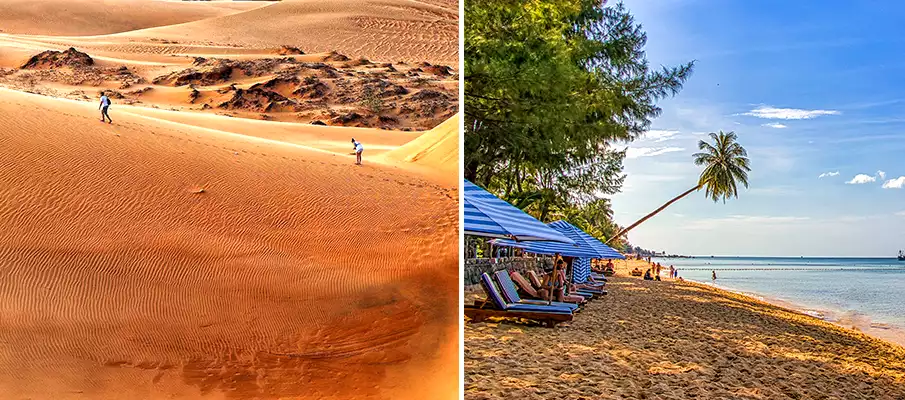
The biggest and popular cities of Southern Vietnam:
These cities offer a diverse range of experiences, from exploring urban attractions and historical landmarks to relaxing on beautiful beaches and immersing in the rich cultural heritage of Southern Vietnam.
-
- Ho Chi Minh City (Saigon): The largest city in Vietnam, Ho Chi Minh City is a bustling metropolis that blends history, culture, and modernity. It is known for its iconic landmarks, lively street markets, and vibrant nightlife.
- Can Tho: Located in the heart of the Mekong Delta, Can Tho is a major city known for its floating markets, where locals trade goods and fresh produce on boats along the river.
- Vung Tau: A coastal city known for its beautiful beaches, Vung Tau is a popular weekend getaway destination for locals and tourists alike. It offers stunning ocean views and a relaxed ambiance.
- Phan Thiet: Famous for its stunning sand dunes and unique fishing villages, Phan Thiet is a coastal city known for its natural beauty and cultural charm.
- Ca Mau: Situated at the southernmost tip of Vietnam, Ca Mau is known for its mangrove forests, ecological diversity, and its significance as the starting point of the country’s coastline.
- Bien Hoa: Located in Dong Nai Province, Bien Hoa is an industrial city that plays a significant role in Southern Vietnam’s economic growth. It is also known for its historic sites and pagodas.
- Long Xuyen: Situated in the Mekong Delta, Long Xuyen is a charming city known for its floating markets, verdant rice paddies, and peaceful canals.
- Rach Gia: Located in the Kien Giang Province, Rach Gia is a coastal city and a gateway to the beautiful islands of Phu Quoc and Nam Du.
- Thu Dau Mot: Thu Dau Mot is the capital of Binh Duong Province and is known for its modern infrastructure and industrial parks, attracting businesses and investors from all over the world.
- Soc Trang: Situated in the Mekong Delta, Soc Trang is a city with a rich cultural heritage, known for its Khmer pagodas, colorful festivals, and unique floating markets.
- Tay Ninh: Tay Ninh is a city near the Cambodian border and is famous for its Cao Dai Temple, an important religious site in Vietnam.
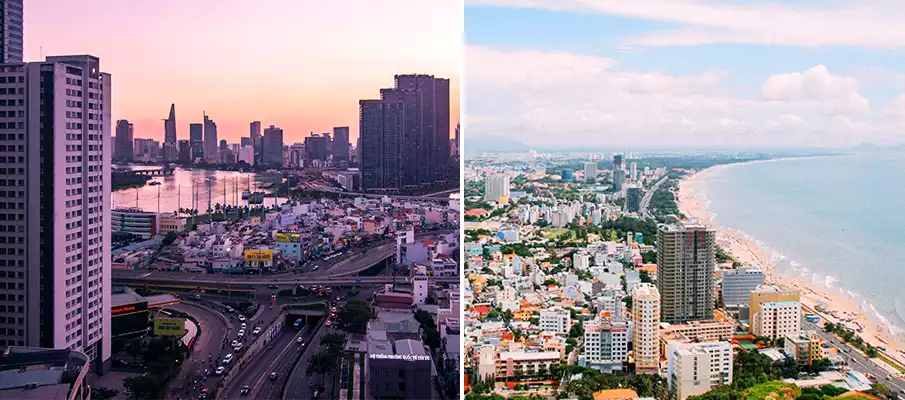
The Most Popular Tourist Sites in Southern Vietnam:
Southern Vietnam is a treasure trove of captivating tourist sites that allure visitors with a perfect blend of rich cultural heritage and breathtaking natural wonders. From vibrant cities pulsating with history to serene landscapes offering tranquility, the region promises an unforgettable travel experience. Here are some of the most popular tourist sites in Southern Vietnam, each with its unique charm:
-
- 1. Ho Chi Minh City (Saigon): The beating heart of Southern Vietnam, Ho Chi Minh City is a vibrant metropolis where modern skyscrapers stand alongside colonial buildings. Tourists can explore iconic landmarks such as the Notre-Dame Cathedral Basilica and the historic Reunification Palace, immersing in the city’s rich history and culture.
- 2. Mekong Delta: A mesmerizing labyrinth of waterways and fertile plains, the Mekong Delta is a cultural and agricultural gem. Travelers can take boat tours to witness floating markets, lush rice paddies, and traditional villages, experiencing the authentic rural life of the region.
- 3. Phu Quoc Island: Phu Quoc Island, known as the „Pearl Island,“ is a tropical paradise with stunning beaches and lush forests. Visitors can indulge in water sports, explore national parks, and unwind in luxurious resorts, making it an idyllic beach getaway.
- 4. Cu Chi Tunnels: History buffs will be enthralled by the Cu Chi Tunnels, an intricate network of underground passageways used during the Vietnam War. Guided tours offer insights into the underground life of the Viet Cong soldiers and their ingenious guerrilla tactics.
- 5. Vung Tau: Nestled on the coast, Vung Tau is a charming city with sandy beaches and picturesque landscapes. Tourists can visit the Christ the King statue on Nui Nho Mountain for panoramic views or relax on the pristine Back Beach.
- 6. Cai Be Floating Market: The Cai Be Floating Market in the Mekong Delta provides an authentic glimpse into the region’s vibrant river trading culture. Visitors can interact with local vendors, savor fresh fruits, and explore the bustling market on wooden boats.
- 7. Mui Ne Sand Dunes: The Mui Ne Sand Dunes are a natural wonder near Phan Thiet, known for their mesmerizing golden sand dunes and breathtaking sunrise views. Tourists can enjoy sandboarding, quad biking, and camel rides in this unique desert-like landscape.
- 8. Con Dao Islands: Off the southern coast, the Con Dao Islands captivate visitors with their serene beauty and historical significance. Known for their unspoiled beaches, marine life, and the Con Dao Prison Museum, the islands offer a mix of relaxation and exploration.
- 9. Cat Tien National Park: Nature enthusiasts can venture to Cat Tien National Park, a biodiversity hotspot with diverse flora and fauna. Trekking, birdwatching, and wildlife spotting offer thrilling adventures in this pristine forest.
- 10. Ca Mau: Situated at the southernmost tip of Vietnam, Ca Mau is known for its mangrove forests, ecological diversity, and its significance as the starting point of the country’s coastline.
- 11. Soc Trang: Situated in the Mekong Delta, Soc Trang is a city with a rich cultural heritage, known for its Khmer pagodas, colorful festivals, and unique floating markets. The Bat Pagoda and Clay Pagoda are among the must-visit religious sites that showcase the region’s diverse cultural influences.
- 12. Tay Ninh: Tay Ninh is a city near the Cambodian border and is famous for its Cao Dai Temple, an important religious site in Vietnam. The temple’s striking architecture and vibrant religious ceremonies attract visitors seeking insights into the unique Cao Dai religion.
BOOK a TOUR / ACTIVITY in Vietnam ➜
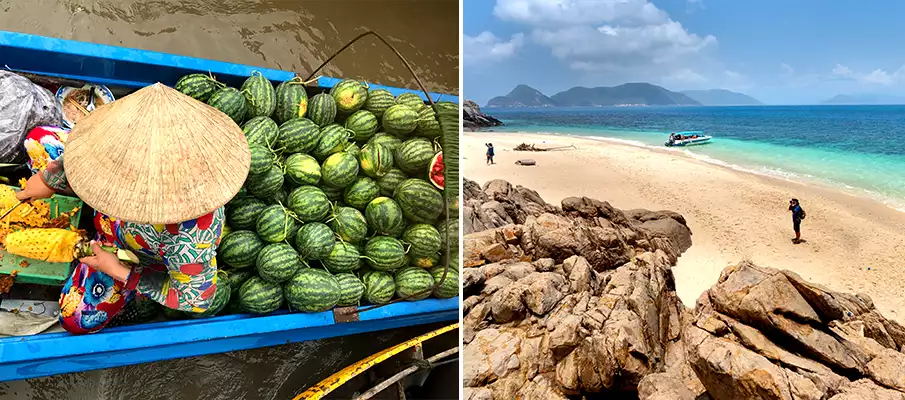
10 Beautiful and Favorite Beaches in Southern Vietnam:
Southern Vietnam is blessed with a stunning coastline that stretches along the South China Sea, offering a plethora of beautiful beaches for sun-seekers and water enthusiasts. From serene hidden gems to vibrant sandy shores, the region boasts a variety of beaches that cater to different preferences. Here are 10 of the most beautiful and favorite beaches in Southern Vietnam:
-
- Phu Quoc Island – Long Beach (Bai Truong): Long Beach on Phu Quoc Island is a true tropical paradise, with powdery white sand and crystal-clear turquoise waters. It’s an ideal spot for beach lovers, where they can relax under swaying palm trees and enjoy stunning sunsets.
-
- Phu Quoc Island – Sao Beach (Bai Sao): Sao Beach on Phu Quoc Island is famous for its powder-soft white sand and shallow azure waters, making it ideal for swimming and sunbathing. The beach’s palm-fringed shoreline adds to its tropical allure.
-
- Vung Tau – Back Beach (Bai Dua): Back Beach in Vung Tau is a popular destination for both locals and tourists. With gentle waves and a laid-back atmosphere, it’s a great place to unwind, swim, and sample fresh seafood from beachside restaurants.
- Vung Tau – Front Beach (Bai Truoc): Front Beach in Vung Tau is a family-friendly destination with calm waters and a range of recreational activities. It’s a great spot for beach volleyball, beach soccer, and picnics.
- Phan Thiet – Ke Ga Beach (Bai Ke Ga): Ke Ga Beach in Phan Thiet is known for its iconic Ke Ga Lighthouse perched on a rocky island just offshore. The beach offers a tranquil escape with soft sands and clear waters, making it a perfect spot for relaxation and picturesque sunset views.
- Phan Thiet – Mui Ne Beach (Bai Bien Mui Ne): Mui Ne Beach is renowned for its unique red and white sand dunes, providing a surreal backdrop to the coastal scene. This beach is a haven for kite surfers and wind surfers, making it an exciting water sports destination.
- Phan Thiet – Hon Rom Beach (Bai Hon Rom): Hon Rom Beach is a hidden gem near Mui Ne, featuring pristine sands and a tranquil atmosphere. The beach is less crowded, making it perfect for a peaceful getaway.
- Con Dao Islands – Dam Trau Beach: Dam Trau Beach on Con Dao Islands is a picturesque gem surrounded by lush greenery and turquoise waters. Its secluded location ensures a serene and unspoiled experience.
- Con Dao Islands – Ong Dung Beach (Bai Ong Dung): Ong Dung Beach on Con Dao Islands is a hidden gem with its pristine shores and emerald waters. Surrounded by lush green hills, the beach provides a serene and secluded setting, making it ideal for a peaceful getaway.
- Ha Tien – Hon Trem Beach (Bai Hon Trem): Hon Trem Beach in Ha Tien is a hidden gem located in the southwestern region of Vietnam. It is known for its pristine shoreline, turquoise waters, and serene surroundings.
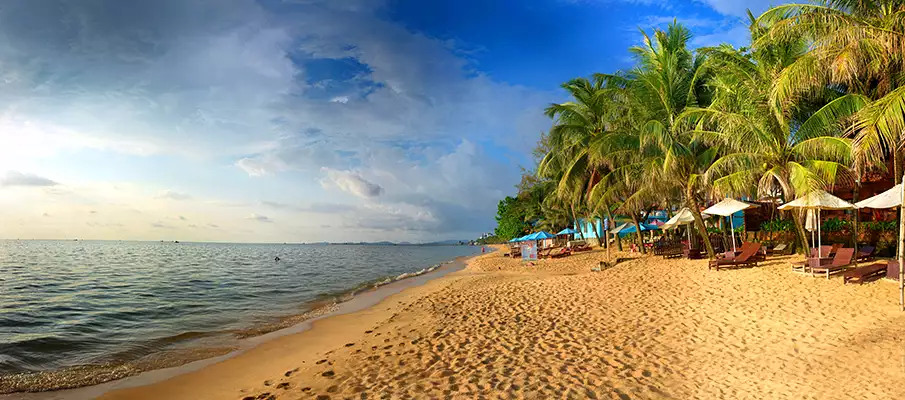
10 Important Historical Sites of Southern Vietnam:
Southern Vietnam is steeped in history, with a legacy shaped by ancient civilizations, colonial influences, and the Vietnam War. From ancient temples and pagodas to remnants of the country’s turbulent past, the region boasts a plethora of historically significant sites. Here are 10 of the most important historical sites in Southern Vietnam:
-
- 1. Cu Chi Tunnels (Ho Chi Minh City): The Cu Chi Tunnels are a system of underground passageways used by the Viet Cong during the Vietnam War. Located near Ho Chi Minh City, this historical site provides insights into the guerrilla warfare tactics employed during the conflict.
- 2. Cao Dai Temple (Tay Ninh): The Cao Dai Temple in Tay Ninh is the main center of the Cao Dai religion, a unique fusion of various belief systems. Its vibrant architecture and colorful religious ceremonies offer a fascinating cultural experience.
- 3. Reunification Palace (Ho Chi Minh City): Also known as Independence Palace, the Reunification Palace in Ho Chi Minh City holds historical significance as the site where the Vietnam War came to an end when a North Vietnamese tank crashed through its gates in 1975.
- 4. Po Sah Inu Cham Towers: Located near Phan Thiet, the Po Sah Inu Cham Towers are ancient Hindu temple ruins built by the Cham people between the 8th and 13th centuries. The site consists of three brick towers dedicated to various Hindu deities and showcases the unique architectural style and religious practices of the Cham civilization that once thrived in the region.
- 5. Con Dao Prison (Con Dao Islands): Con Dao Prison, also known as Poulo Condore, is a historic site on Con Dao Islands with a dark past. During the French colonial era and later in the Vietnam War, the prison was used to incarcerate political prisoners and activists. It serves as a poignant reminder of the harsh conditions and human rights abuses that took place during those tumultuous periods in Vietnam’s history.
- 6. Ba Thien Hau Temple (Ho Chi Minh City): Ba Thien Hau Temple in Ho Chi Minh City is a Chinese-style temple dedicated to the goddess Thien Hau, worshipped for protection from the sea. It represents the significant influence of the Chinese community in the region’s history.
- 7. Vinh Trang Pagoda (My Tho): Vinh Trang Pagoda in My Tho is a stunning Buddhist temple complex featuring a mix of architectural styles, including Chinese, Vietnamese, and Khmer influences. It is one of the most impressive pagodas in the Mekong Delta region.
- 8. Hang Pagoda (Can Tho): Hang Pagoda in Can Tho is an ancient Khmer pagoda with intricate wood carvings and unique architectural designs. Its historical significance lies in its cultural connections with the Khmer community in Southern Vietnam.
- 9. Phan Thiet Water Tower (Phan Thiet): The Phan Thiet Water Tower is an iconic symbol of the city’s history and architectural heritage. Built by the French during the colonial era, it stands as a reminder of Vietnam’s colonial past.
- 10. Ha Tien Fort (Ha Tien): Ha Tien Fort is a historic landmark built during the Nguyen Dynasty to protect the city from invasion. It offers a glimpse into Vietnam’s imperial past and its efforts to defend its territories.
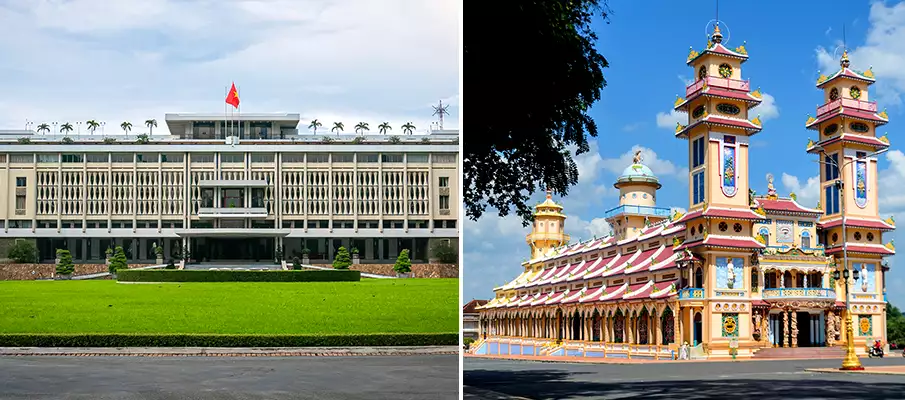
Activities and Adventure for tourists in Southern Vietnam:
Southern Vietnam offers an array of exciting activities and thrilling adventures for tourists seeking to immerse themselves in the region’s natural wonders and cultural experiences. From exploring historic sites to engaging in adrenaline-pumping water sports, there’s something for every adventurous soul. Here are some of the top activities and adventures to enjoy in Southern Vietnam:
-
- Cu Chi Tunnels Exploration (Ho Chi Minh City): Embark on a journey through history by exploring the intricate Cu Chi Tunnels. Crawl through narrow passageways, discover hidden bunkers, and learn about the ingenious guerrilla tactics used during the Vietnam War.
- Water Sports in Phan Thiet and Mui Ne: Phan Thiet and Mui Ne are renowned for their ideal wind conditions, making them perfect destinations for kiteboarding and windsurfing. Thrill-seekers can ride the waves or take lessons from expert instructors.
- Mekong Delta River Cruises (Can Tho): Experience the unique charm of the Mekong Delta with a river cruise. Glide along the waterways, visit floating markets, and observe the traditional way of life in the delta’s riverside villages.
- Trekking in Cat Tien National Park: Nature enthusiasts can embark on a trekking adventure in Cat Tien National Park, a biodiversity hotspot. Traverse through lush jungles, spot wildlife, and immerse in the park’s serene ambiance.
- Snorkeling and Diving in Con Dao Islands: The Con Dao Islands boast pristine waters and vibrant marine life, making them an excellent spot for snorkeling and diving. Explore coral reefs and encounter diverse marine species beneath the waves.
- Snorkeling and Island Hopping in Phu Quoc: Phu Quoc Island is a paradise for snorkeling enthusiasts. Embark on a snorkeling excursion to explore the vibrant coral reefs and underwater marine life in the surrounding clear waters.
- Sand Dune Adventures in Mui Ne: Conquer the towering sand dunes of Mui Ne on a sandboarding or quad biking excursion. The unique landscapes of red and white sand provide an exhilarating desert-like experience.
- Zip-lining in Da Lat: Da Lat offers thrilling zip-lining experiences that take visitors soaring through lush forests and over beautiful valleys, providing breathtaking views of the surrounding landscape.
- River Kayaking in Vung Tau: Paddle along the tranquil waters of Vung Tau, exploring hidden coves and serene riverbanks. River kayaking offers a relaxing and scenic way to appreciate the region’s natural beauty.
- Motorbike Tours in Southern Countryside: Rent a motorbike and embark on an adventure through the picturesque Southern Vietnamese countryside. Witness rural life, lush rice paddies, and charming villages at your own pace.
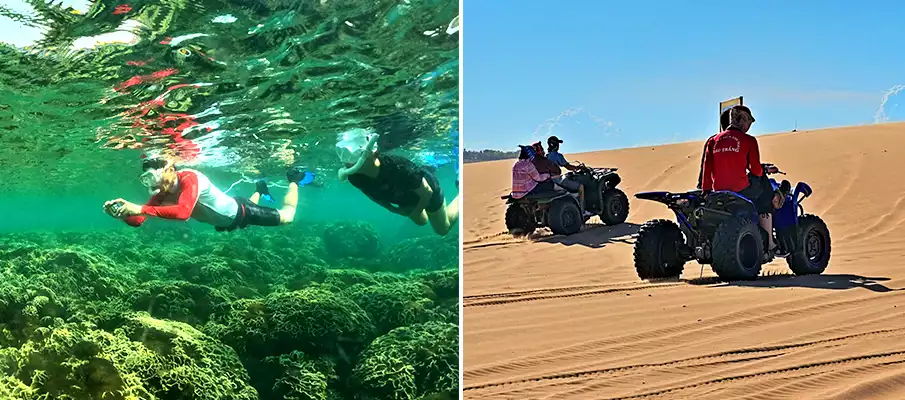
🤔 Why to visit or not to visit Southern Vietnam?
Southern Vietnam offers a diverse array of experiences for travelers seeking to immerse themselves in history, culture, nature, and adventure. With its rich heritage, stunning landscapes, delicious cuisine, and exciting activities, the region beckons travelers from all walks of life. While there are considerations such as weather, cultural sensitivity, and potential language barriers, the enchanting allure and unique experiences of Southern Vietnam make it a captivating destination for those willing to explore and embrace its charm.
👉 Reasons to visit Southern Vietnam:
-
- Rich Cultural Heritage: Southern Vietnam boasts a rich and diverse cultural heritage influenced by various civilizations, including the Cham, Khmer, and Chinese. Visitors can explore ancient temples, pagodas, and historical sites that showcase the region’s unique blend of traditions and architectural wonders.
- Breathtaking Natural Beauty: From the stunning coastline and pristine beaches to lush greenery and picturesque landscapes, Southern Vietnam is a paradise for nature lovers. The Mekong Delta’s intricate waterways, national parks, and mountainous regions offer a diverse range of natural wonders to explore.
- Delicious Cuisine: Southern Vietnamese cuisine is known for its bold flavors and unique dishes. Visitors can savor fresh seafood, aromatic herbs, and delectable street food, making it a gastronomic delight.
- Thrilling Activities: Adventure seekers will find a plethora of activities to indulge in, from exploring historic sites like the Cu Chi Tunnels to engaging in water sports, trekking, and island hopping. Southern Vietnam promises exciting experiences for all.
- Vibrant Urban Centers: Cities like Ho Chi Minh City offer a dynamic and bustling atmosphere, where modernity blends harmoniously with historical landmarks and cultural treasures. The energetic streets, lively markets, and vibrant nightlife create an unforgettable urban experience.
- Charming Beach Destinations: With numerous beautiful beaches along the coast, Southern Vietnam offers ideal beach getaways. Whether you seek relaxation or water sports, the region’s sandy shores have something for everyone.
👉 Reasons not to visit Southern Vietnam:
-
- Hot and Humid Climate: Southern Vietnam experiences a tropical climate with high temperatures and humidity, which may not be ideal for travelers who are sensitive to extreme heat.
- Seasonal Rainfall: The region’s monsoon seasons can bring heavy rainfall, potentially affecting travel plans and outdoor activities during certain times of the year.
- Cultural Sensitivity: As with any destination, it’s essential for travelers to respect local customs and traditions, particularly when visiting religious sites or rural communities.
- Language Barrier: While English is spoken in tourist areas, language barriers may exist in more remote locations, making communication challenging for some travelers.
- Traffic and Congestion: Urban centers like Ho Chi Minh City can have intense traffic, which may be overwhelming for some visitors.
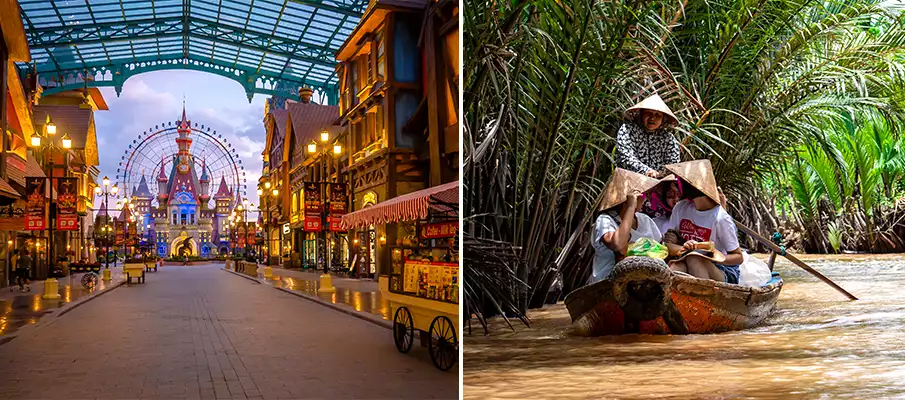
🍜 Food and Cuisine in Southern Vietnam:
Southern Vietnam’s cuisine is a tantalizing fusion of vibrant flavors, fresh ingredients, and a rich culinary heritage influenced by various cultures. From savory dishes that awaken the taste buds to sweet treats that satisfy the soul, the region’s food scene is a gastronomic delight. Here are some highlights of the delectable food and cuisine in Southern Vietnam:
-
- Pho Saigon (Southern-Style Pho): Southern Vietnam is renowned for its unique take on Vietnam’s most iconic dish, pho. Pho Saigon is characterized by a slightly sweeter and bolder broth, accompanied by fresh herbs, bean sprouts, and sliced chili peppers.
- Hu Tieu Nam Vang (Cambodian-Style Noodle Soup): Originating from Cambodia, Hu Tieu Nam Vang is a flavorful noodle soup featuring a mix of pork, shrimp, and squid. The broth is seasoned with garlic, shallots, and fish sauce, creating a delightful and aromatic dish.
- Banh Xeo (Vietnamese Savory Pancake): Banh Xeo is a crispy, golden-yellow pancake filled with shrimp, pork, bean sprouts, and green onions. Eaten wrapped in rice paper with fresh herbs and dipped in a savory fish sauce, this dish offers a delightful explosion of textures and flavors.
- Com Tam (Broken Rice): A quintessential dish of Southern Vietnam, Com Tam features broken rice topped with various grilled meats, pickled vegetables, and a side of sweet and spicy fish sauce. It is a beloved comfort food adored by locals and visitors alike.
- Goi Cuon (Fresh Spring Rolls): Goi Cuon, or fresh spring rolls, are a refreshing appetizer filled with shrimp, herbs, vermicelli noodles, and pork, wrapped in rice paper. Served with a peanut dipping sauce, they offer a light and healthy culinary delight.
- Banh Mi: While Banh Mi is a popular Vietnamese street food enjoyed across the country, Southern Vietnam has its unique variations. The banh mi here often includes a diverse range of ingredients, such as cold cuts, pate, pickled vegetables, and fresh herbs.
- Ca Ri Ga (Chicken Curry): Influenced by Indian and Khmer cuisine, Ca Ri Ga is a fragrant and aromatic chicken curry. The dish features tender chicken simmered in coconut milk with an array of spices, resulting in a comforting and flavorful stew.
- Bun Thit Nuong (Grilled Pork Noodle Bowl): Bun Thit Nuong is a delightful noodle bowl consisting of grilled pork, vermicelli noodles, fresh herbs, and roasted peanuts, topped with a savory fish sauce dressing.
- Che (Vietnamese Dessert Soup): Southern Vietnam is known for its colorful and sweet desserts called Che. Varieties include Che Ba Mau with three colors of mung beans, red beans, and jelly, and Che Suong Sao with sweetened coconut milk and floating star-shaped tapioca.
- Banh Can (Mini Rice Pancakes): Banh Can is a popular specialty in Southern Vietnam, particularly in coastal areas. These mini rice pancakes are cooked in small round molds and typically filled with quail eggs, fresh shrimp, and sometimes ground pork.
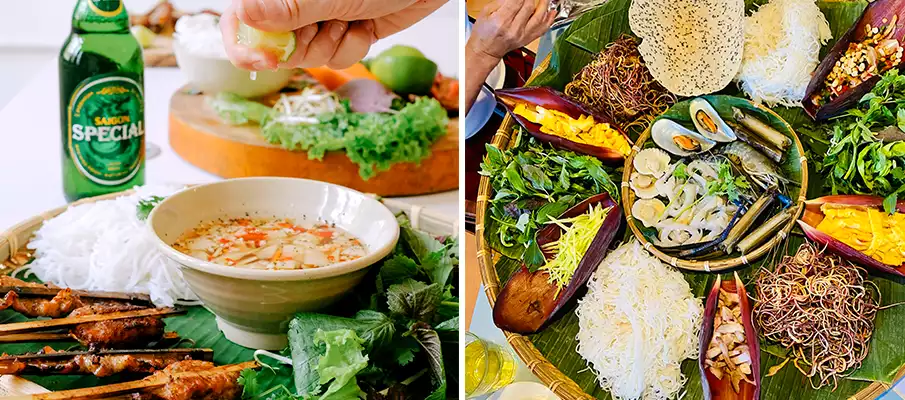
✈️ How to get and travel to Southern Vietnam?
Traveling to Southern Vietnam is relatively straightforward, as the region is well-connected by various transportation options. The most fastest and comfortable option is to take a flight to Ho Chi Minh City. There are also airports on Phu Quoc and Con Dao. Here’s a guide on how to get to and travel within Southern Vietnam:
Getting to Southern Vietnam:
-
- 1. By Air: The most convenient way to reach Southern Vietnam is by flying to Tan Son Nhat International Airport in Ho Chi Minh City. This airport is the largest and busiest in Vietnam, with numerous international and domestic flights.
- 2. By Land: If you are coming from neighboring countries or other parts of Vietnam, you can also consider crossing the land borders. Southern Vietnam shares borders with Cambodia, and there are land border crossings available.
Traveling Within Southern Vietnam:
-
- Domestic Flights: For traveling within Southern Vietnam, you can take domestic flights to major cities and tourist destinations. Domestic airlines offer frequent flights between Ho Chi Minh City, Da Nang, Nha Trang, Phu Quoc, and other cities.
- Trains: Vietnam’s railway network connects major cities in Southern Vietnam, including Ho Chi Minh City, Da Nang, Nha Trang, and Phan Thiet. Trains are a comfortable and scenic option for long-distance travel.
- Buses and Coaches: Buses and coaches are widely available and provide an affordable way to travel between cities and towns within Southern Vietnam. They offer various options, from standard buses to more luxurious sleeper coaches.
- Taxis and Motorbikes: Within cities like Ho Chi Minh City and Da Nang, taxis and motorbike taxis (xe om) are popular modes of transport for short distances. They offer convenience and flexibility, but always ensure to negotiate the fare before starting the journey.
- Renting Motorbikes: Renting a motorbike is a common way for tourists to explore cities and nearby attractions at their own pace. However, only consider this option if you are experienced in riding motorbikes and adhere to safety precautions.
- Boats and Ferries: For destinations like the Mekong Delta or Con Dao Islands and Phu Quoc, boats and ferries are essential modes of transport. They offer scenic journeys and access to remote areas.
- Cyclos and Tuk-tuks: In some cities, cyclos (three-wheeled bicycle taxis) and tuk-tuks are available for short rides or sightseeing tours. Negotiate the fare before starting the ride.
- You can book tickets / flights to Southern Vietnam on Baolau ➜ or 12go.asia ➜

☀️ Weather in Southern Vietnam + The Best Time to Visit:
Southern Vietnam experiences a tropical climate characterized by two main seasons: the dry season and the rainy season. The weather in this region is generally warm and humid throughout the year, with variations in temperature and precipitation based on the seasons.
Dry Season (December to April): The dry season is considered the best time to visit Southern Vietnam. It typically lasts from December to April, with January to March being the peak months. During this time, the weather is mostly dry and sunny, making it ideal for outdoor activities, beach vacations, and sightseeing.
-
- Temperature: Daytime temperatures range from 28°C to 33°C (82°F to 91°F), and nights are cooler with temperatures dropping to around 20°C to 24°C (68°F to 75°F).
- Humidity: Humidity levels are generally lower during the dry season, providing a more comfortable climate for travelers.
- Rainfall: Rainfall is minimal during this period, with only occasional light showers.
Rainy Season (May to November): The rainy season in Southern Vietnam lasts from May to November, peaking between June and August. During this time, the region experiences heavy rainfall and occasional storms.
-
- Temperature: Daytime temperatures remain warm, ranging from 30°C to 35°C (86°F to 95°F), with nights staying relatively warm as well.
- Humidity: Humidity levels are high during the rainy season, leading to a muggy and sticky atmosphere.
- Rainfall: Southern Vietnam receives the majority of its annual rainfall during the rainy season, with frequent heavy showers and thunderstorms.
👉 The Best Time to Visit Southern Vietnam:
The best time to visit Southern Vietnam is during the dry season, from December to April. This period offers pleasant weather, sunny days, and lower humidity levels, providing an ideal environment for exploring the region’s attractions, enjoying outdoor activities, and basking on the beautiful beaches.
For travelers who prefer to avoid the crowds and are willing to deal with occasional rain, visiting during the shoulder months of November and April can also be a good option. The landscape is lush and green from the recent rainfall, and the tourist sites are less crowded.
However, if you plan to visit the Mekong Delta, consider coming during the early rainy season (May and June) when the delta is at its most picturesque, with the rice paddies in full bloom and the rivers brimming with water.
| Month | Weather | Description |
|---|---|---|
| January | Cool and Dry | In January, southern Vietnam experiences cool and dry weather. The average high temperature is around 31°C (88°F), and the low temperature is approximately 21°C (70°F). It’s an excellent time for exploring Ho Chi Minh City, enjoying the Mekong Delta, and visiting nearby beaches. |
| February | Cool and Dry | February continues with cool and dry conditions. The average high temperature remains around 32°C (90°F), and lows are around 22°C (72°F). The comfortable weather is perfect for sightseeing, exploring local markets, and indulging in delicious Vietnamese cuisine. |
| March | Warm and Dry | March brings warm and dry weather to southern Vietnam. The average high temperature is about 34°C (93°F), and lows are around 24°C (75°F). It’s a wonderful time for exploring cultural attractions, cruising the Mekong River, and enjoying local festivals. |
| April | Hot and Dry | In April, southern Vietnam experiences hot and dry conditions. The average high temperature is around 35°C (95°F), and lows are approximately 26°C (79°F). It’s an ideal time for exploring historic sites, enjoying water activities, and experiencing the vibrant city life. |
| May | Hot and Humid | May continues with hot and humid weather. The average high temperature hovers around 35°C (95°F), and lows are around 27°C (81°F). The humidity increases as the rainy season approaches, and occasional rain showers are possible. |
| June | Hot and Humid | June experiences hot and humid weather. The average high temperature is about 34°C (93°F), and lows are approximately 27°C (81°F). The rainfall increases, but there are also periods of sunshine. June is a quieter month for tourists, providing a more relaxed atmosphere. |
| July | Hot and Humid | July remains hot and humid in southern Vietnam. The average high temperature is around 33°C (91°F), and lows are around 26°C (79°F). The rain is more frequent, but it usually comes in short bursts. July is a good time for indoor attractions and city exploration. |
| August | Hot and Humid | August continues with hot and humid weather. The average high temperature hovers around 33°C (91°F), and lows are around 26°C (79°F). The rainfall is more consistent, but it rarely affects outdoor activities. August is a great time for exploring cultural sites and enjoying local cuisine. |
| September | Hot and Humid | September experiences hot and humid weather, with an average high of about 32°C (90°F) and lows of 25°C (77°F). The rain is more frequent, but it usually comes in short, refreshing showers. It’s a good time for indoor attractions and experiencing local life. |
| October | Warm and Dry | October continues with warm and dry conditions. The average high temperature is around 31°C (88°F), and lows are around 24°C (75°F). The weather is suitable for exploring cultural sites, cruising the Mekong Delta, and enjoying city walks. |
| November | Cool and Dry | In November, southern Vietnam experiences cool and dry weather. The average high temperature remains around 31°C (88°F), and lows are around 22°C (72°F). The comfortable weather makes it an excellent time for sightseeing, exploring local markets, and taking part in festive events. |
| December | Cool and Dry | December brings cool and dry weather to southern Vietnam. The average high temperature hovers around 31°C (88°F), and lows are about 21°C (70°F). It’s a great time to explore urban attractions, enjoy the festive atmosphere, and take leisurely boat tours. |
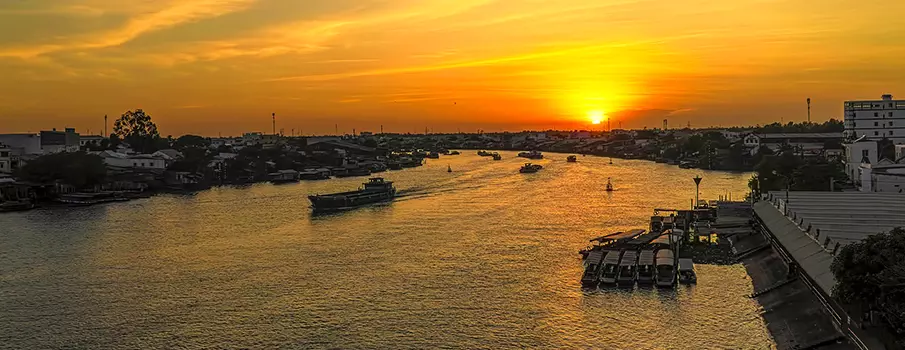
🏡 Accommodation in Southern Vietnam / Where to Stay:
Southern Vietnam offers a wide array of accommodation options to cater to the diverse needs and preferences of travelers. Whether you seek luxury, boutique charm, budget-friendly stays, or immersive cultural experiences, the region’s cities and tourist destinations have something for everyone. Here’s an overview of the accommodation choices in Southern Vietnam:
-
- 1. Luxury Hotels and Resorts: Southern Vietnam’s major cities and island, such as Ho Chi Minh City, Vung Tau, Phan Thiet or Phu Quoc, are home to luxurious hotels and beachfront resorts. These 5-star properties boast world-class amenities, elegant designs, and exceptional service. Many of them feature spa facilities, infinity pools, fine dining restaurants, and stunning views of the city or the sea.
- 2. Boutique and Heritage Hotels: For a unique and intimate experience, boutique hotels and heritage properties are prevalent mainly in the big cities. These hotels often blend traditional Vietnamese architecture with modern comforts, offering guests an authentic and charming stay.
- 3. Mid-Range Hotels and Guesthouses: Mid-range hotels and guesthouses are abundant throughout Southern Vietnam, providing comfortable and affordable accommodation options for travelers. These properties often offer clean and well-furnished rooms, friendly staff, and convenient locations close to popular attractions.
- 4. Budget Hostels and Homestays: Ideal for backpackers and budget-conscious travelers, hostels and homestays are widely available in Southern Vietnam. Hostels offer shared dormitory rooms and communal spaces, fostering a social atmosphere among travelers. Homestays, on the other hand, provide an opportunity to immerse in local culture, staying with a Vietnamese family and experiencing their way of life.
- 5. Eco-Resorts and Farmstays: For those seeking a more rustic and eco-friendly experience, Southern Vietnam has a growing number of eco-resorts and farmstays. These properties often focus on sustainability, organic farming, and environmental conservation, providing a unique and tranquil retreat amidst nature.
- 6. Beach Bungalows and Villas: In coastal destinations like Phu Quoc, Mui Ne, and Con Dao, travelers can find beachfront bungalows and private villas. These accommodations offer direct access to the sandy shores and the sea, making them ideal for beach lovers seeking a relaxing and picturesque escape.
- 7. Apartment Rentals and Airbnb: If you prefer a home-away-from-home experience, Southern Vietnam’s major cities offer a variety of apartment rentals and Airbnb listings. Renting an apartment or a private residence can provide more space and flexibility for families or groups of friends.
➜ Accommodation in Saigon – Book Here
🔍 Interesting Places + Activities in Southern Vietnam:
-
- Ho Chi Minh City (Saigon): Explore the vibrant metropolis of Ho Chi Minh City, known for its bustling streets, historic landmarks like the Reunification Palace and Notre-Dame Cathedral, and vibrant markets like Ben Thanh Market.
-
- Cu Chi Tunnels (Ho Chi Minh City): Venture underground to the Cu Chi Tunnels, a vast network of tunnels used during the Vietnam War. Experience the ingenuity of the tunnels and learn about the war’s history.
-
- Mekong Delta River Cruise (Can Tho): Embark on a scenic Mekong Delta river cruise from Can Tho. Witness the floating markets, traditional villages, and lush landscapes that characterize this iconic region.
-
- Dalat – The City of Eternal Spring: Escape the heat of the lowlands and venture to the charming highland city of Dalat. Known as the „City of Eternal Spring,“ Dalat offers a refreshing change of climate and picturesque landscapes. Explore the French colonial architecture, visit beautiful flower gardens, and immerse in the tranquility of Tuyen Lam Lake.
- Vung Tau – Beach Retreat and Cable Car Ride: Visit Vung Tau, a popular beach destination just a short drive from Ho Chi Minh City. Enjoy relaxing on the sandy shores, visit White Palace, and take a cable car ride to the impressive statue of Jesus Christ on Nho Mountain, offering breathtaking views of the coastal city.
- Cai Be Floating Market (Tien Giang): Experience the authentic charm of the Mekong Delta by visiting Cai Be Floating Market. Witness the lively scene as boats gather to trade a variety of fruits, vegetables, and local products. Take a boat tour through the small canals and explore traditional workshops and orchards along the riverbanks.
-
- Phu Quoc Island and Vinpearl Safari: Escape to Phu Quoc Island’s serene beaches and turquoise waters. Visit Vinpearl Safari, an open zoo where you can observe a wide range of wildlife.
-
- Mui Ne Sand Dunes: Experience the magical Mui Ne Sand Dunes, a unique landscape of red and white sand dunes. Engage in activities like sandboarding and quad biking.
-
- Phan Thiet – Ke Ga Lighthouse: Visit the picturesque Ke Ga Lighthouse in Phan Thiet, offering panoramic views of the coastline and the surrounding sea.
-
- Phan Thiet – Fairy Stream (Suoi Tien): Explore the otherworldly beauty of the Fairy Stream, a small stream with colorful rock formations, and sandy cliffs, creating a mesmerizing landscape.
-
- Con Dao Islands – Con Dao Prison: Discover the tragic history of Con Dao Islands at the Con Dao Prison, a historic site that offers insight into the island’s past as a former prison complex.
-
- Con Dao Islands – Snorkeling and Beaches: Embrace the stunning natural beauty of Con Dao’s beaches and clear waters by snorkeling or relaxing on secluded stretches of sand.
-
- Mui Ne Fishing Village: Experience the authentic lifestyle of a fishing village in Mui Ne. Observe the fishermen’s daily activities and sample fresh seafood from the local markets.
-
- Cai Rang Floating Market (Can Tho): Wake up early to witness the bustling Cai Rang Floating Market, where local vendors trade fruits and vegetables from their boats.
-
- Explore Mekong Delta by Bicycle (Ben Tre): Take a leisurely bicycle ride through the picturesque countryside of Ben Tre in the Mekong Delta, passing by fruit orchards and coconut groves.
📍 Southern Vietnam – Google Map:
❓ Frequently Asked Questions + Tips for Southern Vietnam:
1. How to book and buy tickets or flights to Southern Vietnam?
2. What are the top destinations to visit in southern Vietnam?
-
- Southern Vietnam is home to Ho Chi Minh City (Saigon), the Mekong Delta, Phu Quoc Island, and the beach town of Vung Tau. Each destination offers its own unique attractions, from bustling city life to serene river landscapes and beautiful beaches.
3. When is the best time to visit southern Vietnam?
-
- The best time to visit southern Vietnam is during the dry season, which runs from December to April. This period offers pleasant weather with lower chances of rain, making it ideal for outdoor activities and exploring the region.
4. How do I get around southern Vietnam?
-
- Southern Vietnam is well-connected by various transportation options. Ho Chi Minh City has an extensive network of buses, taxis, and ride-sharing services. To explore other destinations like the Mekong Delta or Phu Quoc Island, you can take domestic flights or use intercity buses.
5. What are the must-try dishes of southern Vietnamese cuisine?
-
- Southern Vietnamese cuisine is famous for its rich flavors. Don’t miss trying dishes like banh mi (Vietnamese sandwich), hu tieu (noodle soup), and com tam (broken rice). Also, sample local specialties like hu tieu My Tho and ca kho to (caramelized fish).
6. Can I take a Mekong Delta tour from Ho Chi Minh City?
-
- Yes, you can take a Mekong Delta tour from Ho Chi Minh City. Many tour operators offer day trips or multi-day tours to explore the floating markets, traditional villages, and lush landscapes of the Mekong Delta region.
7. Is Phu Quoc Island suitable for a family vacation?
-
- Yes, Phu Quoc Island is an excellent destination for a family vacation. The island has beautiful beaches, family-friendly resorts, and various activities like snorkeling, boat trips, and visiting the Vinpearl Safari Park.
8. Are there any historical sites to visit in Ho Chi Minh City?
-
- Yes, Ho Chi Minh City has several historical sites, including the War Remnants Museum, Independence Palace, and Notre-Dame Cathedral Basilica of Saigon. These sites offer insight into Vietnam’s history and culture.
9. What are some eco-friendly activities to do in southern Vietnam?
-
- Southern Vietnam offers eco-friendly activities such as exploring the Can Gio Mangrove Biosphere Reserve near Ho Chi Minh City and visiting local sustainable farms in the Mekong Delta.
10. Can I travel from southern Vietnam to Cambodia?
-
- Yes, you can travel from southern Vietnam to Cambodia. There are various border crossings, and popular routes include traveling from Ho Chi Minh City to Phnom Penh by bus, plane or boat via Chau Doc.
11. Are there any health precautions to consider while traveling in southern Vietnam?
-
- It’s advisable to drink bottled or boiled water, especially in rural areas, to avoid waterborne illnesses. Apply mosquito repellent and wear long sleeves and pants to protect against mosquito-borne diseases like dengue fever.
12. How to get from Ho Chi Minh City to Phu Quoc and Con Dao?
-
- From Saigon to Phu Quoc and Con Dao you can travel by plane – there are direct flights from Tan Son Nhat Airport. There are also boats to Con Dao from Vung Tau or Soc Trang and from Ha Tien and Rach Gia to Phu Quoc.
13. Is it safe to travel in southern Vietnam as a solo traveler?
-
- Yes, southern Vietnam is generally safe for solo travelers. However, like any other destination, it’s essential to exercise caution and take standard safety precautions. Avoid displaying valuables, especially in crowded places, and use reputable transportation options for getting around.
14. What are the most interesting things or facts about Vietnam?
-
- Vietnam, a country with a captivating allure, is celebrated for its breathtaking landscapes, including the mesmerizing limestone karsts of Halong Bay, the terraced rice fields of Sapa, and the bustling waterways of the Mekong Delta. Its rich history unfolds through ancient temples in Hanoi, the imperial city of Hue, and the Cu Chi Tunnels, providing a glimpse into Vietnam’s resilience during wartime. The country’s vibrant culture, delicious cuisine, and warm hospitality further enhance the allure of this Southeast Asian gem. Read this: 15 Interesting Things of Vietnam.
15. What to expect from Vietnam Culture?
-
- Expect a vibrant cultural tapestry in Vietnam, characterized by traditional values, a strong sense of community, and a deep-rooted respect for family. You’ll encounter a fusion of French, Chinese, and indigenous influences in art, architecture, and cuisine. Traditional water puppetry, folk music, and dance performances showcase the country’s artistic flair. The importance of rituals and festivals in daily life adds a colorful dimension, while the warmth and friendliness of the Vietnamese people make for a welcoming and enriching cultural experience.
16. What is the weather in Vietnam and what to expect?
-
- Weather in Vietnam varies with a tropical climate featuring distinct wet and dry seasons. In the north, the dry season (October to April) brings cooler temperatures, while the wet season (May to September) is marked by higher humidity and heavy rainfall. Central Vietnam experiences a dry period (January to August) with lower humidity and a wet season (September to December) characterized by increased rainfall. In southern Vietnam, the dry season (December to April) offers warm temperatures, while the wet season (May to November) brings higher humidity and occasional heavy rainfall. For accurate information, check local forecasts.
BOOK a TOUR / TICKETS in Vietnam ➜
| Interesting Historical Facts about Southern Vietnam: | Description |
|---|---|
| 1. Saigon – The Pearl of the Far East | Saigon, now known as Ho Chi Minh City, was once referred to as the „Pearl of the Far East“ during its French colonial period. The French influence is evident in the city’s architecture, including landmarks like the Notre-Dame Cathedral Basilica of Saigon and the Central Post Office. Saigon played a crucial role in Vietnam’s history as the capital of South Vietnam during the Vietnam War and later as the largest city in reunified Vietnam. |
| 2. French Colonial Legacy | Southern Vietnam was the heart of French colonial rule in Indochina. French colonization in the late 19th and early 20th centuries left a significant impact on the region’s culture, education, and urban planning. The colonial legacy is visible in the city’s boulevards, architecture, and culinary traditions, making it a unique blend of European and Vietnamese influences. |
| 3. Cu Chi Tunnels | The Cu Chi Tunnels, located just north of Ho Chi Minh City, are an extensive network of underground tunnels used by the Viet Cong during the Vietnam War. These tunnels served as hiding spots, supply routes, and living quarters for the guerrilla fighters. Visiting the Cu Chi Tunnels provides insight into the hardships and resourcefulness of the Vietnamese resistance fighters during the conflict. |
| 4. Mekong Delta – The Rice Bowl of Vietnam | The Mekong Delta, often referred to as the „Rice Bowl of Vietnam,“ is an agriculturally rich region that has played a vital role in Vietnam’s history and economy. The vast network of rivers and canals supports the cultivation of rice, fruits, and other agricultural products. The delta’s strategic location has made it a center of trade and commerce throughout history, connecting Vietnam with neighboring countries in Southeast Asia. |
| 5. Battle of Dien Bien Phu | The Battle of Dien Bien Phu, fought in 1954 in Northwest Vietnam, marked the end of French colonial rule in Indochina. While the battle took place in the North, its outcome had a significant impact on the entire country, leading to the 1954 Geneva Accords that temporarily divided Vietnam along the 17th parallel and eventually led to the establishment of South Vietnam and the beginning of the Vietnam War. |
| 6. Can Tho Floating Markets | Can Tho, located in the Mekong Delta, is famous for its vibrant floating markets. These markets, such as Cai Rang and Phong Dien, have been an integral part of the local trading culture for centuries. Farmers and traders gather on boats to sell fresh produce, fruits, and other goods. Visiting the floating markets offers a unique experience, immersing visitors in the traditional river life of Southern Vietnam. |
| 7. Battle of Long Tan | The Battle of Long Tan, fought during the Vietnam War in 1966, was a significant engagement between Australian forces and the North Vietnamese Army and Viet Cong. The battle, which took place in Phuoc Tuy Province, showcased the bravery and resilience of the Australian soldiers in the face of a much larger enemy force. The Battle of Long Tan is considered a pivotal moment in Australia’s involvement in the Vietnam War. |
| 8. Phan Thiet – The Cham Kingdom | Phan Thiet, a coastal city in Southern Vietnam, has a historical connection to the ancient Champa Kingdom. The Champa people, who were predominantly Hindu, established several temples and relics in the region. The Po Sah Inu Towers, located near Phan Thiet, are among the well-preserved Cham ruins that reflect the area’s rich historical heritage. |
| 9. French Architecture in Vung Tau | Vung Tau, a seaside resort town, boasts a collection of well-preserved French colonial buildings. During the French colonial period, Vung Tau was developed as a popular coastal destination for French officials and expatriates. Some of the notable buildings include the White Villa (Villa Blanche) and the Vung Tau Lighthouse, both of which provide a glimpse into the town’s colonial past. |
| 10. The Fall of Saigon | The Fall of Saigon in 1975 marked the end of the Vietnam War and the reunification of Vietnam. On April 30, 1975, North Vietnamese forces captured Saigon, leading to the dissolution of the South Vietnamese government and the establishment of a unified socialist republic. This historic event changed the course of Vietnam’s history and signaled the beginning of a new era for the country. |
Hoi An – Travel Guide|Da Nang – Travel Guide|Phong Nha – Travel Guide|Quy Nhon – Travel Guide|Koh Phi Phi – Travel Guide|Koh Lipe – Guide

